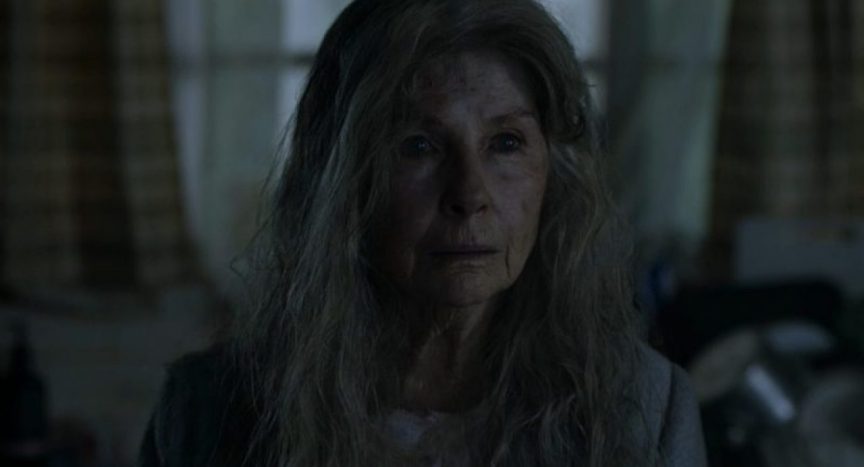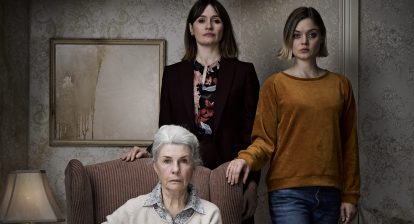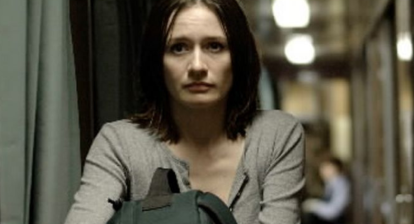Relic is one of the best horror films of the decade. Natalie Erika James’ first feature tells the story of three generations of women: Edna (Robyn Nevin), Kay (Emily Mortimer), and Sam (Bella Heathcoat). Edna, who’s suffering from dementia, has gone missing, prompting Kay and Sam to search for her.
RELATED: Relic is a Thoroughly Impressive Debut
I was lucky enough to attend a roundtable with James and all three of Relic’s principal performers discussing the film with writers from various outlets. The four had a lot to say about their new movie, which has been garnering great responses from critics. It opens to the public on Friday.
James, who also co-wrote the script for Relic, says that, “apart from the personal inspiration… The film is an accumulation of everything you consume in your life. All the horror films, the gothic literature, art that you research. You do a lot of visual research to come up with the imagery too.” She recently found a notebook and says, “the first line I had written on it was, ‘A young woman tries to save her Grandma in a house that’s bigger on the inside than the outside.’” She goes on to acknowledge Mark Z. Danielewski’s excellent novel House of Leaves as an influence as well as “childhood nightmares… and real life horror. People in their vulnerability and their fragility.”

All of these influences shine in Relic, coming together to build something larger than the individual parts. The performers could see that reading the script, which convinced them to sign on. Heathcote says, “The script grabbed me. It’s rare that you read a script like this full stop, but it’s rare that you read a horror script where you’re kind of emotionally invested. I didn’t want to put it down. The end of the film gut-punched me in the best possible way.”
Mortimer agreed, adding, “It was so recognizable and truthful, the feeling of going home to be with your parents and how that makes you feel both full of love and safe, and yet also, full of all sorts of confusion and strange emotions.” Nevin shared, “I’m a mother and a grandmother. It’s certainly not my story, but I recognize so many elements that I instinctively understood it.”
The performers bring that script to life wonderfully. As anyone who sees Relic will tell you, it succeeds in large part because of the authenticity of the relationship between the three generations of women on screen. It’s not a surprise that their rapport showed through in the roundtable. Nevin says there was “an ease with which everyone moved into relationships with each other. Everybody was very open and quite at ease and very much themselves… I loved them all. It helps.” Mortimer echoes that sentiment, “I feel so psyched about these three women that I now count as friends. They’re properly funny, bright, and really down-to-earth, all of them. Normal and kind of crazy of course, because otherwise I wouldn’t really be interested.” Heathcote added, “We were all in this together. We could laugh at ourselves. Being able to laugh when things got really dark was a lovely escape.”
 The set was more relaxed partially because of that laughter, and partially because nearly all the talent in front of and behind the camera was female. It was the first time Mortimer, who made her first filmed appearance in 1994, worked on such a set. It reminded her, “How cool women are. I’ve never had an experience working just with three other women. That was really the experience… It was so different, not having the presence of an Alpha guy around really did feel different… there’s normally a guy around to queer the pitch and complicate things in an annoying way.”
The set was more relaxed partially because of that laughter, and partially because nearly all the talent in front of and behind the camera was female. It was the first time Mortimer, who made her first filmed appearance in 1994, worked on such a set. It reminded her, “How cool women are. I’ve never had an experience working just with three other women. That was really the experience… It was so different, not having the presence of an Alpha guy around really did feel different… there’s normally a guy around to queer the pitch and complicate things in an annoying way.”
That was a surprise to James, who says, “I’m used to working with a lot of women. It wasn’t distinctive to me… I prefer a more laid back set and a more collaborative atmosphere and it’s just natural to have women as components of that.” Nevin certainly felt that, saying, “I found the atmosphere much, much calmer. More simpatico, and more helpful than in other less female-centric settings.” For her part, Heathcote says, “I definitely felt like with Natalie and Emily and Robyn, there was this space that was great between us. It was safe to go there. There was someone to throw a hand down when you fell in the hole to pull you out afterward… It’s something I haven’t experienced on a set before. There’s normally a lot more yelling.”

NOTE: IF YOU CROSS THIS LINE YOU’RE ENTERING SPOILER TERRITORY FOR RELIC
In addition to the three women, the house in Relic feels like its own character. James talked about how they built it. “The house was a combination of two locations and a studio build. One house in Melvin was the exterior. There was another one that was largely the interior of the downstairs and the staircase. Then on the soundstage we built the upstairs bedrooms, and we had to rebuild parts of the hallway as well to give it that connective tissue and make it feel seamless. Our production designer, Steven Jones-Evans, did a phenomenal job concocting all that. And of course, the labyrinthe itself was built on a soundstage. For budget reasons, we had to make it modular so we could take out areas and put up a different wall so we could make it feel like a different space.”
Heathcote, whose character traverses the labyrinth in Relic‘s final act says, “It was as intense as it looked. I feel like I owned recently how I had a hissy fit. I was there for maybe four or five days and it was a lot of running around, screaming, banging on walls. On that last day, Natalie, who’s very precise as a director, wanted one more take. The moment I’m least proud of was kind of being like, ‘I’m not a robot, Natalie.’ It was pretty gnarly… I can’t really complain because it did most of the work for me. I didn’t really have to generate that much because it was all there to scare the bejesus out of me.”
 When asked if there was a moment when Natalie knew how good Relic was, she says, “There are definitely scenes during the shoot when as someone who’s written it and as the director that one-hundred percent that you feel magic the magic of them on screen during that day. But because the process of post is so long—it’s nine months of staring at the same thing—you do become quickly kind of, not numb, but the effect starts to wear off a bit. Certainly, I couldn’t have anticipated the positive response to the film so far.”
When asked if there was a moment when Natalie knew how good Relic was, she says, “There are definitely scenes during the shoot when as someone who’s written it and as the director that one-hundred percent that you feel magic the magic of them on screen during that day. But because the process of post is so long—it’s nine months of staring at the same thing—you do become quickly kind of, not numb, but the effect starts to wear off a bit. Certainly, I couldn’t have anticipated the positive response to the film so far.”
Heathcote was less uncertain. She says, “I read this script and I thought it was phenomenal, but it’s that thing where you go, ‘it could be so wonderful.’ But when you get to that last scene, if that doesn’t work then the whole film is gone. I certainly couldn’t envisage how that would look when I was reading it even though I was moved by it. But I remember someone telling me, ‘You can trust a director if they give good notes to the other actors and if it makes the other actors better.’ I remember coming on the set early on and watching the notes Natalie gave two actors who were already fantastic and it would make them even better… every note Natalie gave was a good one. Seeing the Other as well, finding the creature so heartbreaking and bizarrely beautiful.”
RELATED: Repulsive Beauty: The Attraction to Monsters in the Films of Clive Barker
Everyone in the film had strong reactions to Relic’s ending with the Other, so it may be a surprise that James had considered other endings. She says, “The ending was originally different in its first form, probably in the first draft. Even the characters were slightly different. There was a husband character for Kay, a brother character for Sam. It was substantially different, but the sentiment was the same. It always ended on a note of connection among this horrific examination of aging and dementia… the skin peeling came mid-development.”
Despite having it since mid-development, they did shoot two versions. James says, “In terms of the skin peeling, that was all the same. But the last note, when Sam discovers the bruise on Kay’s back, we did have a version where Kay discovers a bruise on herself. I personally felt it was stronger that it was Sam’s discovery because it lends itself more to the cyclical nature of things.”
 The scene was shot on Mortimer’s last day on set. Heathcote says, “Oh my, God. What a way to go out.” She says the ending, “was so tender and loving, that moment of acceptance after all that horror. I get emotional thinking about that scene.” Nevin wasn’t there to film it, but says she found watching it “Very affecting… in the scene where she’s carrying her mother up the stairs, I started to go then. But the action within the scene, of the peeling, was just so extraordinary.”
The scene was shot on Mortimer’s last day on set. Heathcote says, “Oh my, God. What a way to go out.” She says the ending, “was so tender and loving, that moment of acceptance after all that horror. I get emotional thinking about that scene.” Nevin wasn’t there to film it, but says she found watching it “Very affecting… in the scene where she’s carrying her mother up the stairs, I started to go then. But the action within the scene, of the peeling, was just so extraordinary.”
For Mortimer, who’s castmates affectionately call her “the peeler,” “that scene, from the moment I read it to being in it to watching it, it was the same feeling of just, I have never considered or thought of, it was something that I couldn’t in a million years have imagined. This notion. It’s so wild. It’s so out there. It’s so outrageous and strange and crazy and horrifying, and yet feels so familiar.”
You can see Relic‘s amazing ending on demand (it’s in theaters too, but seriously don’t go to a movie theater in the middle of a f***ing pandemic) starting today, Friday, July 10th.



